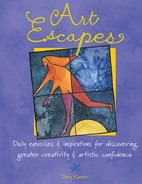3
Opportunities for Everyday Creative Moments
Very often I am sitting at dinner and take out my notebook. I get very inspired when I eat, for some reason.
~ Claes Oldenburg
I believe that when it comes to art, quantity equals quality. The more art you do, the better you get. The sheer quantity of creation leads to an enhanced quality of self-expression. The more images you create, the more fluid your imagination becomes. That’s where keeping an artistic journal comes in. Fill your pages with observations every day—the more the better. This chapter is designed to help you discover creative moments in your day that you may not have realized were there. Imaginative opportunities lie camouflaged in our everyday lives. The projects in this chapter will help you create art out of the unexpected, and find inspiration for paintings from surprising sources.
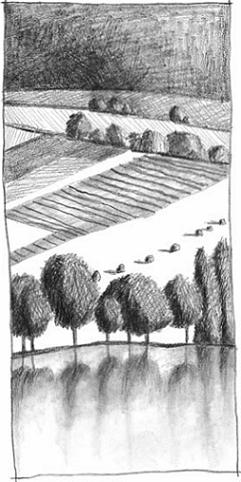
RIVER REFLECTIONS
Watercolor on Arches 140-lb. (300gsm) cold-pressed paper 26" × 20" (66cm × 51cm) Collection of Jean Auel
Creative Doodling
Life is full of situations where it is easy to feel creatively trapped. Do you have a lengthy meeting to attend, or anticipate a long wait at the airport? Commit an act of creativity. These are perfect moments for creative doodling. Don’t we all love to doodle? Let your pencil do what it wants, without censoring—even though your concentration might be centered elsewhere. I love to doodle while talking on the telephone. Creative ideas flow when you are not trying so hard to be ingenious. Journal opportunities will abound.
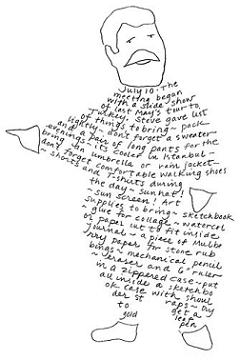
Why Can’t Business Meetings Be Fun?
Take meeting notes by adding the figure to a quickly sketched face. This mustachioed caricature started as a doodle of a gentleman’s face as he was speaking at a meeting I attended. My handwritten notes of his comments form the simple body shape.

The Caricature Doodle
Next time you’re at a lecture, convention or meeting make quick cartoon caricatures of the participant’s faces. Pick out one distinguishing feature—earlobes with dangly earrings, a thick head of curly hair, arching eyebrows, a pointy chin—and draw that first. Next, add the outline of the jaw and chin shape. Add a squiggly line for the hair. You can scribble just a pair of glasses on a circle, or a big mustache on an oval. This is not a drawing, not a sketch—it’s a doodle! Jot down the name of your subject by your caricature for an artful way of remembering names and faces.

Frame Your Day With a Doodle Border
Some days all I want to do is create a border design in my artistic journal. Maybe I’ll return to it later on, and fill in the empty space in the middle, or maybe not. I find it energizing to make spontaneous, unplanned designs. First, make doodles, in pencil or pen, all around the four edges of a new page in your journal. Play with simple shapes and repeating patterns in a free-form kind of way. There is no right or wrong. I don’t try to draw anything from reality—just squiggles, lines, dots and shapes. Doodle while on the telephone, at a meeting, listening to music or even watching TV. With your conscious mind occupied, you liberate your unconscious to reveal itself.
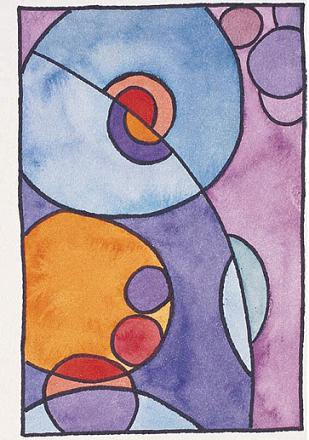
Discover Personal Symbols in Your Doodles The design for this watercolor painting came directly out of the doodle border. Take note of the shapes or marks that appear in your doodles. They are your personal hieroglyphics. I noticed that both circles and squares, and parts of them, turned up over and over again in my doodle. I enlarged two elements of my doodle border into this composition of overlapping spheres. Aristotle said that “the soul never thinks without a picture.” Bring meaning to your work by awakening to this rich source of personal imagery.
The Creative Matrix
Growing up, one of my favorite summer activities was catching fireflies at night. Those few seconds holding the glowing insect in my loosely cupped hands, examining it for just a moment before letting it go free, delighted me. The creative matrix permits a similar kind of momentary examination of fleeting but precious moments. Celebrate a day, week, weekend, workshop, travel adventure or any other life experience. Visual and written note taking raises the ordinary to the extraordinary. The creative matrix is a private diary that helps you hold onto meaningful everyday moments and illuminate personal memories.

Weekend Matrix
This is a creative matrix I made while at our vacation cabin in central Oregon. There are so many things I love about being there. The matrix framework helped me to focus on just three of these— the flora, fauna and mountain vistas. In trying to decide upon my matrix categories, I realized that these were the subjects I was most interested in during a short two-day visit. Creative limits encourage self-discovery. The framework of the matrix keeps me from being overwhelmed by the possibilities and helps me focus my attention on the slice of life truly important to me right now.

Workshop Matrix
I made this creative matrix while I was attending a writing workshop on the Pacific coast. I used two facing pages of my journal, which gave me more room to draw, paint and make written notations. This matrix is a valued remembrance of a wonderful weekend staying with good friends and being inspired by writer Kim Stafford. I kept notes of this delightful weekend within the framework of my artistic journal matrix. The first creative choice is deciding which categories to illuminate. I’m glad I preserved some of the essence of my experience by focusing on Kim’s quotes, highlights, land and sea, and small treasures. After I decided on the categories, the matrix gave me a structure for reflection, a creative way to reveal delicious morsels of meaningful memories.
Make a Creative Matrix This Weekend
What do you love about each season? How do you mark the turning from summer to autumn? Winter to spring? Use the creative matrix as a way to chronicle the changes you observe. Pick several categories or qualities about each season to investigate. Another approach is to make four identical seasonal matrices maintaining the same categories for each one for an ongoing investigation of the progression of the yearly cycle. Colors, foliage and birds are examples of facets to explore. Leave room in your journal for the four matrices so one can flow right after the other. Sometimes, we overlook the rich creative opportunities—such as the seasons— that are all around us.

Copy This Matrix Template Into Your Journal
Use this design as a template for your first weekend matrix. Enlarge it to the size of one of your journal pages. Photocopy or trace it into your sketchbook. This is an invitation to make a hand-drawn, handwritten illuminated manuscript of your weekend. Interpret the categories as broadly as you wish. Draw, write, collage, doodle, make lists—anything goes. Don’t stick to strict grid boundaries, I never do. Pick a weekend with nothing special going on. The matrix is about moments, not the momentous. You’ll find there is a lot more to remember than you would have guessed.
Matrix Categories to Get You Started
This list contains some areas of observation that you might find useful in building your own matrix. This is just a beginning: There are as many possible categories as there are facets to your life. In other words, they are endless. The important thing is to create categories for your matrix that encourage you to focus in on slender, but precious, aspects of your experience. Each matrix you make will be different. Through each one, by committing to a few choices out of the myriad of possibilities, you intensify your powers of observation. Not only is this true of making a matrix, but it is true of life itself. Art imitates life, once again!
Senses
Sights
Scents
Sounds
Tastes Touch/textures
Nature
Flora and fauna
Feathers and beaks
Land and sea
Waves and clouds
Sun and rain
Sticks and stones
Light and shadow
Natural wonders
Travel
Getting ready
Getting there
Being there
Going home
Local color
Vistas and views
Bathrooms everywhere
Cafés of note
Joys and woes
New friendships
Hotels rooms
Cameos and brief encounters
Cultural differences
Les faux pas
Architectural details and
decorative motifs
Trains, planes, automobiles and boats:
the details
On the go and slowing down
Shopping memories
Crossing boundaries
Street signs and lamp posts
Packing tips
Local cuisine and personal picnics
My own maps
In the market today
What I miss about home
Books I took and books I read
People and Family
Friends, yesterday and today
Making connections
Building bridges
Hurdles and agonies
Quotable quotes
Truth and lies
Love and admiration
Still growing
New best friends
Just About Me
Simple pleasures and little luxuries
Choices and challenges
Foolish fun and folly
Life’s little lessons
Awakenings and inspiration
Rest and recreation
Random thoughts
Dreams and imagination
Moments of grace or virtue
Fun and laughter
If I could do it all over again…
Advice taken and not taken
Being alone
Highlights of the day
Memorable moments
Books to read
Moments of celebration
Emotions
Everyday magic
Spontaneity
Reactions Passions
Clarity or confusion
Surprises and questions
Worries and scary
moments
Windowpane Painting
![]() PAGE-A-DAY IDEA
PAGE-A-DAY IDEA
Life is a Verb
Discover a symbol of yourself by looking through magazines for illustrations of people in motion—dancing, flying, jumping, digging, falling, sleeping, swimming and so on. Don’t overlook illustrations or photographs of animals in action. Animals are powerful symbols of the self. Think about your life in terms of a characteristic movement or pursuit. What action suggests your life right now? What verb describes your current energy and essence? Borrow an image from a book or magazine illustration that speaks to you. As Pablo Picasso said, “Good artists copy, great artists steal.” Rework your borrowed image into a simple drawing representing your present state of mind. The key is simplicity. Use this image to make a symbolic self-portrait windowpane painting.
Many of these journal projects are designed to nudge you, the artist, into framing or reframing what you see. Windowpane painting asks the artist to imagine an uncomplicated image, bordered by the architecture of four windowpane sections. Each windowpane alters the image slightly, tinting it with different textures and hues. The simpler the subject, the stronger the windowpane painting—a perfect combination for sketchbook art. I love to watch how one image comes together like four separately hand-painted tiles.
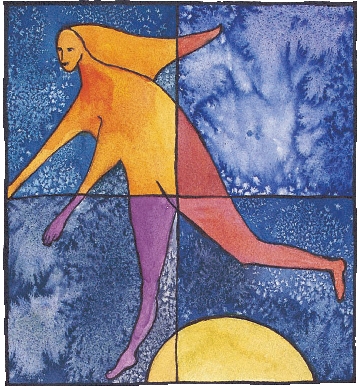
The Escape Artist
This windowpane painting came from a tiny sketch made while my husband and I were driving in rural France. I saw a billboard with a childlike figure and did a quick one minute sketch while on the road. Later on, I designed a figure of my own and had her fly in the sky over a full moon. I call this painting The Escape Artist. It is a favorite private symbol. With sketchbook and pencil in hand, I can escape to a personal place of reverie, no matter where I am. The background areas were sprinkled with salt while the paint was still wet to create the star patterns.
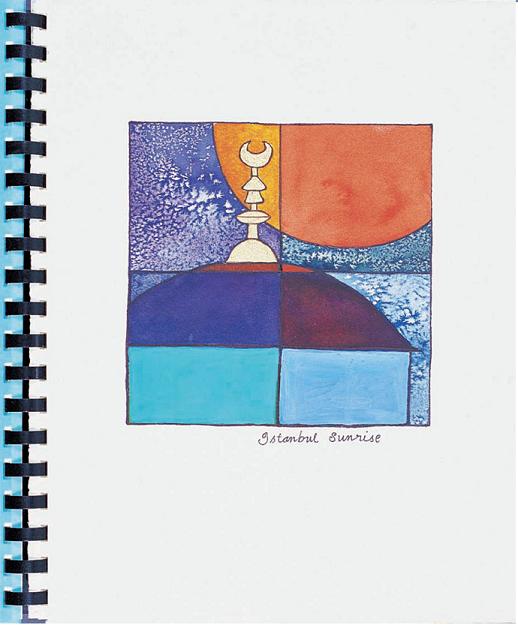
Turkish Colors Grace a Painting
I painted this windowpane painting in my Komtrak binder journal, using watercolor paper that can be inserted into the binding. While in Turkey, I admired the luminous effect of the remarkable Iznik tile work facing the interior and exterior of many Ottoman buildings. I borrowed the colors characteristic of Iznik tile work for this painting of a mosque at sunrise—rich red, orange, turquoise, blue and green. I finished the painting by adding metallic gold accents from my Krylon gold leaf pen. All the elements of this design, including the crossed lines of the windowpanes, were outlined with black felt-tip pen.
Demonstration: Don’t Just Shop for Dinner
MATERIALS
Arches 140-lb. (300gsm) cold-pressed paper
Drafting tape
Full-spectrum triad pigments Permanent Rose, Winsor Blue (Red Shade), Winsor Lemon
Pencil
Pigma Micron .50mm black pen or waterproof felt-tip pen
No. 4 round
Table salt
![]() Use the hidden opportunity of your routine grocery shopping to beckon a creative moment into your day. Pick out one beautiful piece of fruit or vegetable to use as a subject for a windowpane painting. Who knows? This could be the beginning of a charming kitchen series.
Use the hidden opportunity of your routine grocery shopping to beckon a creative moment into your day. Pick out one beautiful piece of fruit or vegetable to use as a subject for a windowpane painting. Who knows? This could be the beginning of a charming kitchen series.

1 Trace the Design
Enlarge this drawing of a pear on a photocopier and trace it onto a piece of 140-lb. (300gsm) cold-pressed watercolor paper sized to fit inside your journal. An easy way to trace is to place the photocopy behind your piece of watercolor paper and secure them to a bright window. You will be able to see the photocopy from behind the watercolor paper. Be sure to draw the crossed lines creating the four squares. Tape the edges with drafting tape to make painting the borders of the design easier.
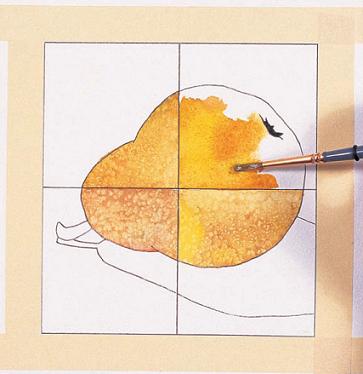
2 Paint the Pear in Sections
Using the full-spectrum triad, mix different colors for each of the four pear sections and paint each one. While the paint is still shiny wet, sprinkle it with salt to create a textured, naturalistic pear surface. Be sure to let each section dry before going onto the next one.

3 Paint the Four Background Sections
Using the full-spectrum triad, mix four different purple colors for each of the four background shapes. Your background painting will be untextured, while the pear shapes are by contrast textured with salt. This is the opposite of my examples, The Escape Artist and Istanbul Sunrise. There are many ways to go with windowpane painting.
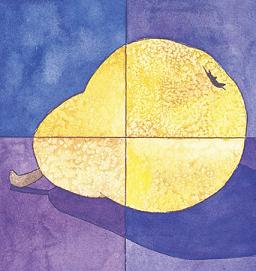
4 Paint the Stem
Paint the stem using a mixture of dark brown paint. When dry, darken the shadow areas in the two bottom sections. You may want to review the section on color mixing grays and darks with triads.
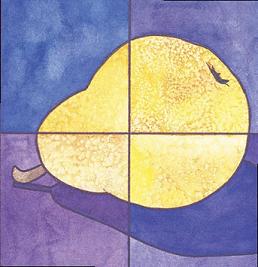
5 Outline All Shapes and Lines
Once you are sure everything is dry, remove the drafting tape. Go over all the lines of the pear, shadow, windowpanes and outside edges with waterproof felt-tip pen or black ink pen.
Room With a View
I love to look at landscapes framed by a window. When I lived in China, one of my special pleasures was riding on trains and viewing the passing landscape enclosed by the window and the ubiquitous white embroidered curtains. Hotel rooms, restaurants, portholes, my own home, friend’s homes, they all provide unexpected opportunities for the landscape painter. For a new twist on the theme, draw everything inside the room with pen, adding watercolor only to the scenery outside the window. This fresh technique gives the viewer a sense of being in the room with the artist, while letting the landscape outside the window take center stage.
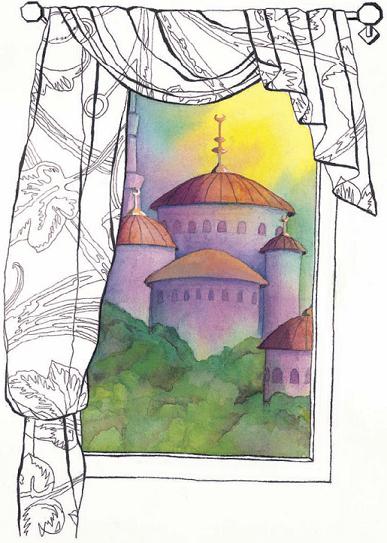
Ink the Interior, Paint the Exterior
I love to make room-with-a-view paintings of each of my hotel rooms when I’m traveling. I am always intrigued with the view, no matter what it is. In this case, my Istanbul hotel room offered an architectural and atmospheric treasure. I used pen to draw in the outlines of the window and the elaborate drapery. I went over some of the pen lines to emphasize the folds and edges of the fabric. Before painting the towers and domes of the Blue Mosque, I underpainted the entire area of the exterior landscape with soft pastel colors suggesting the golden glow of the rising sun. I wet the whole window area first with clean water, then dropped diluted mixtures of the full-spectrum triad onto the damp paper. After this soft underpainting dried, I completed the painting by adding architectural details of the mosque and the trees in the foreground.
Demonstration: Capture Simplicity and Sophistication
MATERIALS
Arches 140-lb. (300gsm) cold-pressed paper
Full-spectrum triad pigments Permanent Rose, Winsor Blue (Red Shade), Winsor Lemon
No. 2 round
Pencil
Pigma Micron .50mm black pen or waterproof felt-tip pen
![]() I spent a peaceful weekend at a friend’s home in the country. The lovely view out the window summed up my feelings for their warm and cheerful home. The combination of ink for the window and watercolor for the landscape outside, helped contrast the sophisticated interior of the room with the rustic landscape. I painted the scene outside the window with a childlike primitive quality to convey the simple pleasures of their country life.
I spent a peaceful weekend at a friend’s home in the country. The lovely view out the window summed up my feelings for their warm and cheerful home. The combination of ink for the window and watercolor for the landscape outside, helped contrast the sophisticated interior of the room with the rustic landscape. I painted the scene outside the window with a childlike primitive quality to convey the simple pleasures of their country life.
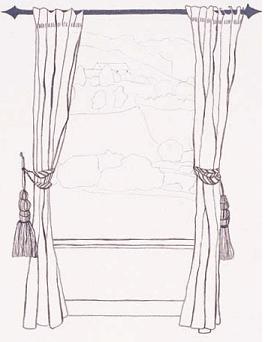
1 Draw the Window and Curtains
On a piece of watercolor paper sized to fit your sketchbook, draw the window ledge, window frame, curtains and other features of the room using a black felt-tip pen. Draw the scene outside the window lightly in pencil. The great part is that your composition is already framed for you by the boundaries of the window.
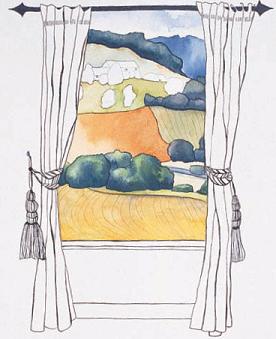
2 Bring Color to the Landscape
With the full-spectrum triad, paint the landscape framed by your inked window. I made a rich variety of greens using my method for mixing brights and shades with the full-spectrum triad.
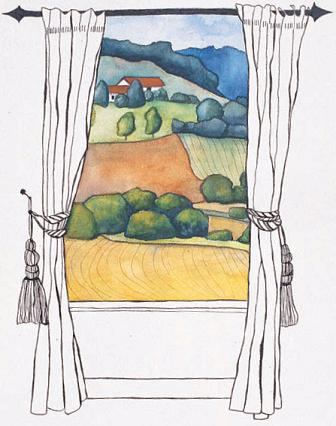
3 Add Details
Add a few details and the painting is complete.
Travel Art Tips
![]() PAGE-A-DAY IDEA
PAGE-A-DAY IDEA
The Collection
One of the joys of travel is becoming aware of the differences between cultures. Gather a group of items spiced with the local color— objects delightfully different from home or special in some singularly foreign way. The subjects of your journal collections are direct reflections of what you uniquely observe and love about the country, state or city you visit.
I think it’s obvious—I love to keep artistic journals when I travel. Café art, the creative matrix, watercolor mosaics, one minute drawings—so many of the projects in this book were born while pursuing my practice of journaling when I travel. My children keep travel journals, too. They especially love suggestions for new, freeing formats. It’s also fun to collaborate on journal pages with your travel partners. But, perhaps my favorite travel moments are those quiet, private ones, sitting in a shady café, drawing and painting. Here are a couple of my favorites for you to try on your next journey.

A Collection of the Ice Creams of France
I never could have predicted the fabulous flavors of ice cream in southern France. I realized on my first day in Nice that I had to make an exhaustive, personal study of the subject. My husband was happy to offer his assistance as we sampled an array of ice-cream cones during my journal “research.” First, I put empty ice cream cone paintings on my page, then filled in the names of the flavors and colors of the ice-cream scoops as I went along. It took me two weeks to finish this travel journal page. I patiently waited for the most amazing flavors to appear before including them in my collection. Here are the flavors I discovered: Violet, Honey-Lavender, Lavender, Green Apple, Tomato-Basil, Olives of Nice.
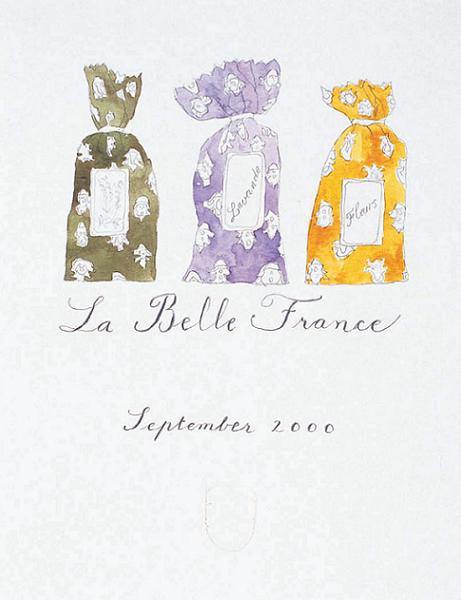
Sachets Adorn My Title Page
This is the frontispiece, or title page, of one of my travel journals. I always begin with a page indicating the destination and the date. On the day we arrived, I fell in love with these little lavender sachets sewn with colorful provençal fabrics. This page is a collection, first drawn in pencil, then painted in watercolor. A simple idea can create a beautiful travel memory page.
Observation Icons
Isolate small aspects of your travel experience into delicious visual treats. Observation icons are painted symbols of the beauty of the natural world, edged with silver or gold, displayed on your journal page with raised mounting tabs. One approach is to choose a single theme for a group of icons on a page. Another is to devote a whole page to one special image. We all seem to appreciate the natural world more when we travel, when we see with refreshed eyes. Perhaps it is because we take the time to really look that makes the difference.

Six Views of the Sea
I made this page of observation icons while sailing on the Aegean off the southern coast of Turkey. The sea was so beautiful—tinged and altered by the time of day, the light, wave patterns and weather. I wanted to record daily views of this fascinating phenomenon. Each day for six days, I painted one of the watercolor paper squares with the colors, textures and patterns I saw in the sea. I colored the edges of each sea icon with my Krylon gold leaf pen. I attached each icon to my journal page with four double stick mounting tabs, one on each corner. Each sea image is labeled with the place and the date.
Demonstration: Create an Observation Icon
MATERIALS
Arches 140-lb. (300gsm) cold-pressed paper cut into small squares
Full-spectrum triad pigments Permanent Rose, Winsor Blue (Red Shade), Winsor Lemon
Double stick mounting tabs, available at most office and craft stores
Gold Krylon pen
No. 4 round or medium Niji waterbrush
Pencil and pens
![]() These geraniums were one of many that graced the courtyard of my hotel in Bodrum, Turkey. They are the perfect example to demonstrate how to make an observation icon. I love to use a medium sized Niji waterbrush when I travel. It holds water inside the handle. All you do is squeeze and clean water comes out.
These geraniums were one of many that graced the courtyard of my hotel in Bodrum, Turkey. They are the perfect example to demonstrate how to make an observation icon. I love to use a medium sized Niji waterbrush when I travel. It holds water inside the handle. All you do is squeeze and clean water comes out.

1 Create a Small Painting
Cut a small piece of watercolor paper, and paint the pot of geraniums. Use the full-spectrum triad, which is perfect for the bright, primary colors of this vibrant environment.
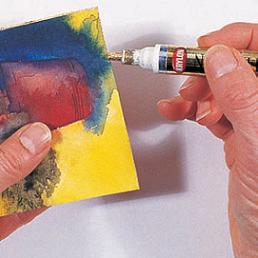
2 Gold Leaf the Edges
Color the edges of the finished painting with a Krylon gold leaf pen, creating the effect of a gold frame. Be sure to go over the edges two times with the gold pen to ensure an even metallic coating.

3 Press on Mounting Tabs
When the gold ink is dry, attach four double stick mounting tabs to each corner of the back of your painted observation icon and place it in the center of your sketchbook page.

4 Place Your Creation
Add a title and caption, including the place and date. This example shows just one observation icon. The painted image is highlighted with the raised mounting and the gold leaf edging.

